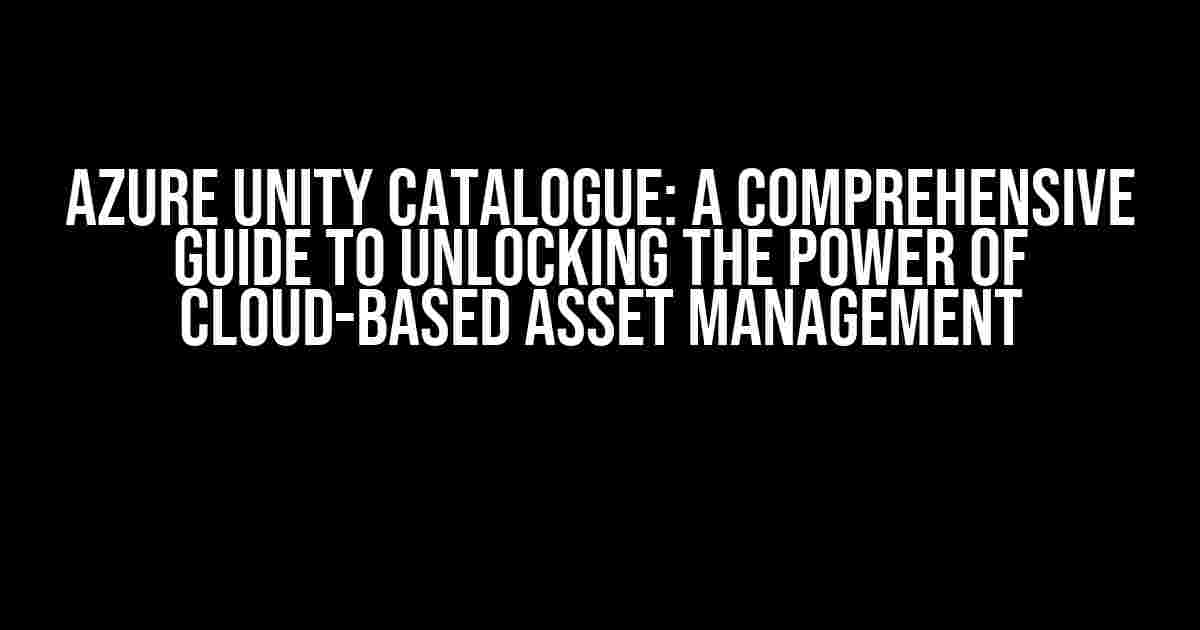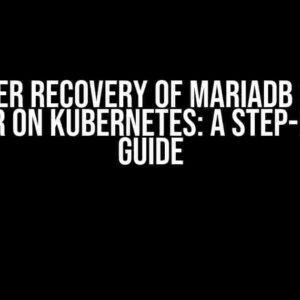Are you tired of juggling multiple asset management tools and struggling to keep track of your organization’s digital assets? Look no further than the Azure Unity Catalogue, a game-changing solution that streamlines asset management and revolutionizes the way you work with digital assets in the cloud. In this article, we’ll delve into the world of Azure Unity Catalogue, exploring its features, benefits, and step-by-step instructions on how to get started.
What is Azure Unity Catalogue?
Azure Unity Catalogue is a cloud-based asset management solution that enables organizations to catalog, manage, and govern their digital assets across multiple platforms and environments. It provides a single, unified view of all your assets, making it easier to discover, manage, and utilize them efficiently. With Azure Unity Catalogue, you can break down silos and ensure that your assets are consistent, up-to-date, and compliant with organizational standards.
Key Features of Azure Unity Catalogue
- Centralized Asset Management: Azure Unity Catalogue provides a single pane of glass for managing all your digital assets, including data, applications, and infrastructure.
- Automated Asset Discovery: The solution automatically discovers and catalogs assets across multiple environments, including on-premises, cloud, and edge platforms.
- Real-time Inventory: Azure Unity Catalogue provides a real-time inventory of your assets, ensuring that you always have an up-to-date view of your digital landscape.
- Advanced Search and Filtering: The solution offers advanced search and filtering capabilities, making it easy to find and manage specific assets based on various criteria.
- Customizable Asset Taxonomy: Azure Unity Catalogue allows you to create a customized asset taxonomy that aligns with your organization’s specific needs and requirements.
Benefits of Azure Unity Catalogue
By implementing Azure Unity Catalogue, organizations can reap a wide range of benefits, including:
- Improved Asset Utilization: With a single, unified view of all your assets, you can optimize asset utilization, reduce duplication, and eliminate unnecessary costs.
- Enhanced Collaboration: Azure Unity Catalogue enables cross-functional teams to collaborate more effectively, reducing silos and improving communication.
- Increased Asset Security: The solution provides robust security features, ensuring that your assets are protected from unauthorized access and misuse.
- Faster Time-to-Value: Azure Unity Catalogue accelerates time-to-value by providing rapid access to assets, reducing the time spent on manual searches and asset tracking.
- Better Compliance and Governance: The solution enables organizations to maintain compliance with regulatory requirements and industry standards, ensuring that assets are properly governed and managed.
Getting Started with Azure Unity Catalogue
Implementing Azure Unity Catalogue is a straightforward process that requires some planning and preparation. Here’s a step-by-step guide to get you started:
Step 1: Plan Your Asset Taxonomy
Before implementing Azure Unity Catalogue, it’s essential to plan your asset taxonomy. This involves identifying the types of assets you want to manage, the metadata you want to associate with each asset, and the relationships between different assets.
Example Asset Taxonomy:
* Applications
+ Web Applications
+ Mobile Applications
+ Desktop Applications
* Data
+ Customer Data
+ Financial Data
+ Operational Data
* Infrastructure
+ Servers
+ Storage
+ Network Devices
Step 2: Set Up Azure Unity Catalogue
Once you have planned your asset taxonomy, you can set up Azure Unity Catalogue. This involves creating an Azure Unity Catalogue instance, configuring the solution, and integrating it with your existing infrastructure and tools.
Azure CLI Command to Create an Azure Unity Catalogue Instance:
az unitycatalogue create --name <instance_name> --resource-group <resource_group>
Step 3: Configure Asset Discovery
Azure Unity Catalogue provides automated asset discovery capabilities that can be configured to scan your infrastructure and platforms for digital assets.
Azure CLI Command to Configure Asset Discovery:
az unitycatalogue discovery create --name <discovery_name> --resource-group <resource_group> --scope <subscription_id>
Step 4: Customize Your Asset View
Once you have set up Azure Unity Catalogue and configured asset discovery, you can customize your asset view to meet your specific needs. This involves creating custom dashboards, reports, and visualizations to provide insights into your digital assets.
| Asset Type | Metadata | Relationships |
|---|---|---|
| Web Application | URL, Description, Owner | Dependencies: Database, Server |
| Customer Data | Name, Email, Phone | Related Assets: Sales Records, Marketing Campaigns |
Best Practices for Azure Unity Catalogue
To get the most out of Azure Unity Catalogue, it’s essential to follow best practices that ensure data quality, security, and governance. Here are some tips to keep in mind:
- Maintain Accurate and Up-to-Date Asset Information: Ensure that your asset metadata is accurate, complete, and up-to-date to ensure that your asset view is reliable and trustworthy.
- Implement Robust Security and Access Controls: Configure Azure Unity Catalogue to enforce robust security and access controls, ensuring that only authorized personnel can access and manage assets.
- Establish Clear Governance Policies: Develop clear governance policies and procedures for managing assets, ensuring that they align with organizational standards and regulatory requirements.
- Monitor and Analyze Asset Utilization: Regularly monitor and analyze asset utilization to identify opportunities for optimization, reduction, and improvement.
Conclusion
Azure Unity Catalogue is a powerful solution that streamlines asset management and enables organizations to unlock the full potential of their digital assets. By following the steps outlined in this article, you can implement Azure Unity Catalogue and start realizing the benefits of improved asset utilization, enhanced collaboration, and increased security. Remember to plan your asset taxonomy, set up Azure Unity Catalogue, configure asset discovery, customize your asset view, and follow best practices to ensure success.
With Azure Unity Catalogue, you can revolutionize the way you work with digital assets and take your organization to the next level. So why wait? Get started with Azure Unity Catalogue today and discover the power of cloud-based asset management!
Frequently Asked Question
Get the most out of Azure Unity Catalogue with our expert answers to your burning questions!
What is Azure Unity Catalogue, and how does it help me?
Azure Unity Catalogue is a centralized metadata repository that enables data discovery, management, and governance across your entire data estate. It helps you by providing a single source of truth for all your data assets, making it easier to find, understand, and use the right data for informed decision-making.
How does Azure Unity Catalogue integrate with my existing data infrastructure?
Azure Unity Catalogue seamlessly integrates with various data sources, including Azure Synapse Analytics, Azure Databricks, Azure Storage, and more. It also supports popular data formats and protocols, such as CSV, JSON, and ODBC, making it easy to connect and catalog your existing data infrastructure.
Can I customize Azure Unity Catalogue to fit my organization’s specific needs?
Absolutely! Azure Unity Catalogue is highly customizable, allowing you to tailor it to your organization’s unique requirements. You can create custom metadata models, add business-specific annotations, and even integrate with existing systems and tools to ensure a seamless fit with your existing workflows.
How does Azure Unity Catalogue address security and compliance concerns?
Azure Unity Catalogue takes security and compliance seriously, with built-in features like fine-grained access controls, data encryption, and auditing. It also supports popular compliance standards, such as GDPR, HIPAA, and CCPA, to help you meet your organization’s regulatory requirements.
What kind of support and resources are available for Azure Unity Catalogue?
Microsoft offers comprehensive support and resources for Azure Unity Catalogue, including extensive documentation, tutorials, and community forums. You can also leverage Microsoft’s 24/7 technical support and consulting services to help you get the most out of your investment.




